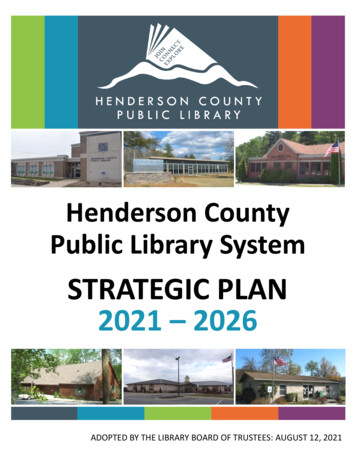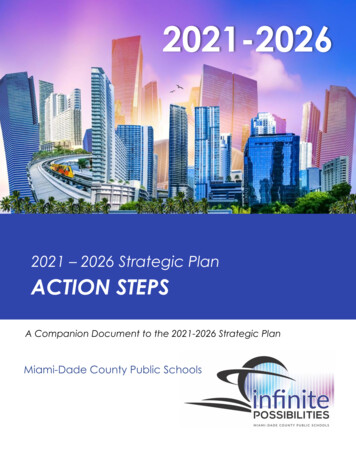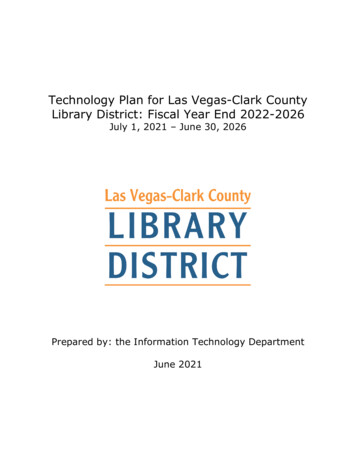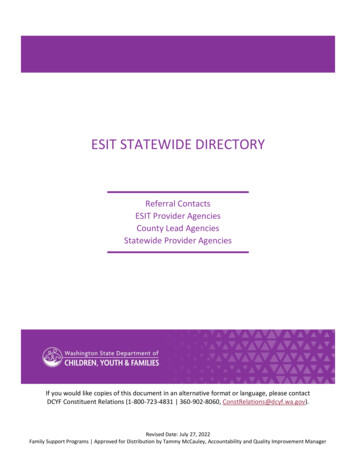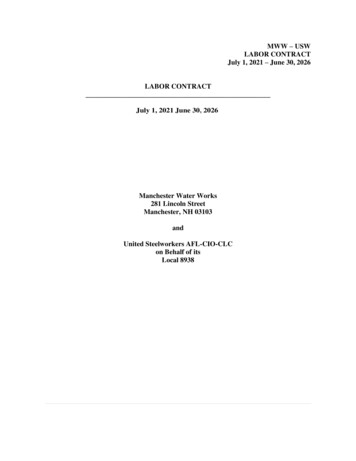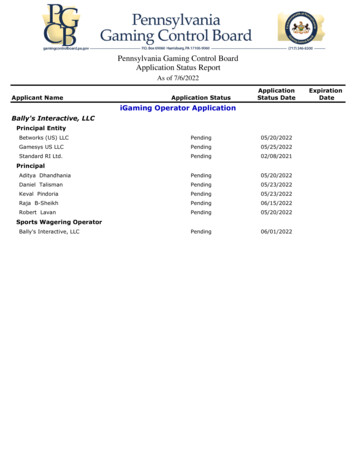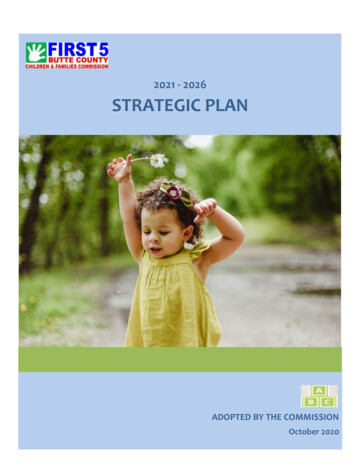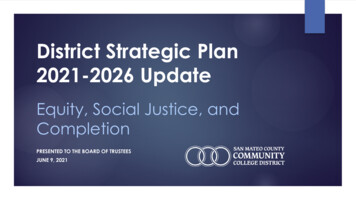
Transcription
District Strategic Plan2021-2026 UpdateEquity, Social Justice, andCompletionPRESENTED TO THE BOARD OF TRUSTEESJUNE 9, 2021
Presentation Agenda1.Process for the District Strategic Plan Update2.Environmental Scan1.External Context2.Internal Context1.District Enrollment Trends3.Strategic Goals and Districtwide Strategies4.Free Community College Initiative
District StrategicPlan Process
Strategic Plan Update TimelineDistrict Strategic Plan Review plement(Year 2)(Year 3)(Year 4)PlanUpdate(Year 1)———(Year ��Assess—Assess—Assess2020/212021/22Plan Update ComprehensiveContinuedPlan UpdateCompleted(Year 6 )(Year 1)
Timeline of ActivityNamePositionDateActivityLocationAaron McVean (Chair)Vice Chancellor, Educational Services andPlanningOctober 15th2019First meeting of the DSP Steering CommitteeDistrictDave MandelkernTrusteesTom NurisNovember 13th DSPSC #2: District Mission and College Strategic PlansDistrictDecember 9thDistrictOctober 7th2020DSPSC #4: Strategic Goals and Districtwide Strategies ReviewCSMDSPSC #4.5: Strategic Goals and Districtwide Strategies Review Districtcont.COVID-19DSPSC #5: District Strategic Plan Metrics ReviewZoomOctober 14thBoard Study Session: District Strategic Plan ProgressZoomNovemberCollege Planning Council PresentationsZoomJamillah MoorePresident (Cañada College)January 28thJeramy WallaceDistrict Academic Senate President (CSM)February 18thGolda MargateCSEA Representative (Skyline College)Jordan Chavez (2019-20)Student TrusteesJade Shonette (2020-21)Karen EngelDean of PRIE (Cañada College)Hilary GoodkindDean of PRIE (CSM)Ingrid VargasDean of PRIE (Skyline College)DSPSC #3: Environmental Scan and SWOT Analysis2021January - March Academic Senate PresentationsZoomMarch 3rdClassified Senate PresentationsDSPSC #6: Final ReviewZoomJune 9thBoard PresentationZoomJune 23rdBoard AdoptionTBD
Environmental Scan:External Context
San Mateo CountyEducational Attainment
Equity and Completion Although high overall, disparitiesexist in high school graduationrates among student groupsbased on race and ethnicity. Hispanic/Latinx, African American,and AIAN students experiencelower graduation rates.
Equity and Completion The lowest rates of completion ofUC/CSU requirements (“a-g”) areseen in the Hispanic/Latinx, PacificIslander, African-American, andAIAN student populations. Expansion of Dual Enrollment, aspart of Strategic Goal #2 and akey component of the FreeCommunity College initiative, isspecifically intended to addressthis issue.
San Mateo County High School TrendsProjected
Equity and Completion Disparities persist inper capita incomebased on raceand ethnicity. The robust growthin the Silicon Valleyeconomies has notbenefited specificcommunities ofcolor to the sameextent as others.
Equity and Completion The most significant factorthat influences income iseducational attainment. In San Mateo and SiliconValley economies,educational attainmenthas a greater impact onpotential income thanother areas of the State.
Equity and Completion When unemployment is high itdisproportionately impactscommunities of color. Resiliency during economic downturns that result in higherunemployment depends onhaving higher educationalattainment.
Equity and Completion A high level perspective on majoremployment sectors in the regionshows that while the largestemployment sector is CommunityInfrastructure and Services, themajority of jobs in that sector arelow-skill/low-wage jobs.
Equity and Completion Aligning programs with potentialfor employment in sectors, andpositions within sectors, thatprovide sustainable income is acontinued focus for the DistrictStrategic Plan and completionefforts.
Equity and Completion Communities of color,Hispanic/Latinx and AfricanAmerican communitiesspecifically, have the highestproportions of householdsliving below the selfsufficiency standard. Educational attainment isone of the largest factorsthat determines the ability toachieve self-sufficiency.
Environmental Scan:Internal Context
SMCCCD Enrollment Trends
SMCCCD Enrollment Trends Amidst an overalldecline in enrollment,there has beenconsistent growth inDual Enrollment ofhigh school students,thanks to effortsprimarily at SkylineCollege.
SMCCCD Enrollment TrendsFACE TO FACE9%1%90%ONLINEHYBRIDFACE TO FACE12%1%88%11%4%85%HYBRIDONLINE 2165517,580Based on April 2021survey of 3,338 students,post pandemic, 45% ofstudents reportedwanting to take acombination of online,in-person, and hybridlearning options, withan additional 27%interested in takingmostly online learning.
Strategic Goalsand DistrictwideStrategiesEQUITY, SOCIAL JUSTICE, &COMPLETION
Strategic Goals and Districtwide StrategiesDistrictwide Strategies Continually explore and implement interventions that benefit all students and help them to achieve theirspecific educational goals. Measure the impact of new and existing Districtwide efforts to increase access, success, and completionwhile reducing equity gaps for disproportionately impacted student groups. Support the Colleges by providing resources for innovative teaching and learning that is designed to increasestudent success. Fully implement and optimize the Salesforce CRM and associated products in order to integrate technologysystems for better communication to students, staff, and faculty. Support the implementation of the District’s sustainability initiatives to address its program goals as part of theDistrict’s response to climate change. Support the work of the District Anti-Racism Council to radically reimagine how we commit to anti-racism andhow we can transform the educational experiences for all students, especially hyper-marginalized students. Expand the Promise Scholars Program to serve all students who are interested and qualify for this completionfocused program.
Strategic Goals and Districtwide StrategiesStrategic Goal #1DEVELOP AND STRENGTHEN EDUCATIONAL OFFERINGS, INTERVENTIONS, AND SUPPORT PROGRAMS THAT INCREASE STUDENTACCESS, SUCCESS, AND COMPLETIONDistrictwide Strategies Encourage the development of methodologies that increase the number of students who utilize support services that enablethem to stay in school and succeed. Create on-line and web-based options for students to access advising and counseling services, interactive scheduling, andeducational plans. Strengthen the alignment of career education programs with projected workforce needs. Provide professional development resources for faculty, staff, and administration to ensure program effectiveness andexcellence in teaching and learning. Establish a dedicated budget for new program development in order to increase access, success, and completion, andeliminate equity gaps. Review student placement processes and incorporate multiple measures of assessing the preparedness of new students forcollege level work with the goal of decreasing time needed to achieve one’s goal. Use emerging practices to accelerate student progression of ESL sequences into transfer-level courses. Evaluate the implementation of revised placement processes for English, and math, ensuring students are successful intransfer-level coursework. Systematically evaluate the effectiveness of academic and student support programs in all areas and develop, strengthen,or eliminate programs to support student success.
Strategic Goals and Districtwide StrategiesStrategic Goal #2ESTABLISH AND EXPAND RELATIONSHIPS WITH SCHOOL DISTRICTS, 4-YEAR COLLEGE PARTNERS, COMMUNITY-BASED ORGANIZATIONSAND EMPLOYERS TO INCREASE HIGHER EDUCATION ATTAINMENT AND ECONOMIC MOBILITY IN SAN MATEO COUNTYDistrictwide Strategies Increase collaboration, interaction, and alignment with high school partners to increase successful transitions from local highschools to ensure higher education is accessible for all San Mateo high school students. Continue to expand and support Middle College and Early College opportunities. Expand dual enrollment opportunities and make processes more efficient and accessible for secondary schools and theirstudents. Create faculty-to-faculty collaboration as part of high school partnerships for Dual Enrollment and Guided Pathways to betteralign curricula and to create seamless transitions from secondary to postsecondary education.
Strategic Goals and Districtwide StrategiesStrategic Goal #2ESTABLISH AND EXPAND RELATIONSHIPS WITH SCHOOL DISTRICTS, 4-YEAR COLLEGE PARTNERS, COMMUNITY-BASED ORGANIZATIONSAND EMPLOYERS TO INCREASE HIGHER EDUCATION ATTAINMENT AND ECONOMIC MOBILITY IN SAN MATEO COUNTYDistrictwide Strategies Work with feeder high schools to streamline processes for sharing transcript information to facilitate placement of morestudents into the appropriate transfer-level credit courses. Create an active campus environment that creates a sense of belonging and engagement for students. Increase and articulate Guided Pathways, programs, and services to improve career development and job placement tohelp students meet their stated goals. Increase/expand partnerships with four-year colleges and universities to increase seamless curriculum alignment and directprogram transfer, as well as develop opportunities to complete four-year degrees in San Mateo County. Share data and information, especially about student success, with community partners.
Strategic Goals and Districtwide StrategiesStrategic Goal #3PROMOTE INNOVATION AND EXCELLENCE IN INSTRUCTION TO SUPPORT STUDENT LEARNING AND SUCCESSDistrictwide Strategies Expand program delivery options, including accelerated completion options, for all students including online students, e.g.,College for Working Adults; short-term classes; intersession classes; cohort classes; and continuing, corporate andcommunity education. Promote strategic development of online education to increase the development and delivery of quality, fully onlinecertificate and degree programs. Support professional development for faculty and staff to incorporate advances in teaching, learning, and effective use oftechnology. Increase technology use in the classroom and develop the overall District technology infrastructure to support innovativepractices in teaching and learning. Integrate technological systems to ensure a seamless and efficient experience for students, faculty, and staff.
Strategic Goals and Districtwide StrategiesStrategic Goal #3PROMOTE INNOVATION AND EXCELLENCE IN INSTRUCTION TO SUPPORT STUDENT LEARNING AND SUCCESSDistrictwide Strategies Ensure student and academic support services are accessible to all students in the online environment. Support innovation and excellence by increasing the availability of data and information to inform the effectiveness ofprograms and interventions designed to increase student success, equity, and achievement. Support the International Student Programs and expand International Education to provide a global education and campusculture that benefits all students. Foster an environment that continues to attract and retain highly qualified and dedicated faculty, staff, and administrationthat share the District’s values of equity and social justice. Accelerate the development and adoption of Open Educational Resources (OER) and expand Zero Textbook Cost (ZTC)course offerings for students across all modalities.
Strategic Goals and Districtwide StrategiesStrategic Goal #4ENSURE NECESSARY RESOURCES ARE AVAILABLE TO IMPLEMENT THIS STRATEGIC PLAN THROUGH SOUND FISCAL PLANNING ANDMANAGEMENT OF ALLOCATIONS. PROTECT COMMUNITY-SUPPORTED STATUS AND UNDERTAKE THE DEVELOPMENT OF ALTERNATIVESOURCES OF REVENUE THAT SUPPORT EDUCATIONAL PROGRAMS BEYOND THAT WHICH IS AVAILABLE FROM COMMUNITY AND STATEALLOCATIONS.Districtwide Strategies Protect and solidify District funding, predominately in the form of property taxes, through interaction and advocacy with keycounty and state legislators and the State Chancellor’s Office. To ensure this is achieved, build coalitions among othercommunity-supported districts and statewide associations. Increase actions across the District to provide alternative revenue sources to support programs that increase student success,equity, and completion. Expand the development, management, and grant funding strategy and infrastructure for the District and its Colleges. Increase philanthropic development efforts in order to provide resources that can be used to support programs and effortsthat increase student success, equity, and completion.
Strategic Goals and Districtwide StrategiesStrategic Goal #4ENSURE NECESSARY RESOURCES ARE AVAILABLE TO IMPLEMENT THIS STRATEGIC PLAN THROUGH SOUND FISCAL PLANNING ANDMANAGEMENT OF ALLOCATIONS. PROTECT COMMUNITY-SUPPORTED STATUS AND UNDERTAKE THE DEVELOPMENT OF ALTERNATIVESOURCES OF REVENUE THAT SUPPORT EDUCATIONAL PROGRAMS BEYOND THAT WHICH IS AVAILABLE FROM COMMUNITY AND STATEALLOCATIONS.Districtwide Strategies Increase Community, Continuing and Corporate Education (CCCE) training and services to San Mateo County residents,families and public and private sector organizations through increased lifelong learning and professional certifications foradults, expanded academic and fitness programming for youth, and customized workforce training for public and privatesector organizations. Increase credit-based enrollments through new credit/not-for-credit hybrid programming. Contribute to the economic development of San Mateo County through collaborative partnerships with industry andworkforce/economic development agencies. Partner with local, regional, and state level governmental and other agencies in order to achieve the strategic goals of theDistrict. Review allocations and evaluate the investment of resources in order to align resource allocation with District strategic goalsand Districtwide strategies that increase student success, equity, and achievement.
Free CommunityCollege InitiativeEQUITY, SOCIAL JUSTICE, ANDCOMPLETION
Free Community College Initiative Key Components CCAP Dual Enrollment ComponentProposedInvestmentPromise Scholars ProgramCCAP Dual Enrollment 2.50 millionPromise Scholars Program 3.00 million OER/ZTC ExpansionOER/ZTC Expansion 1.25 million Legislative and PolicyChangesTotal Proposed for Tentative Budget 6.75 million
Thank you!QUESTIONS AND COMMENTS?
November 13 th DSPSC #2: District Mission and College Strategic Plans. District: December 9 th DSPSC #3: Environmental Scan and SWOT Analysis. District: 2020 January 28 th DSPSC #4: Strategic Goals and Districtwide Strategies Review . CSM: February 18 th DSPSC #4.5: Strategic Goals and Districtwide Strategies Review cont. District: COVID-19 October 7 th DSPSC #5: District Strategic Plan .
